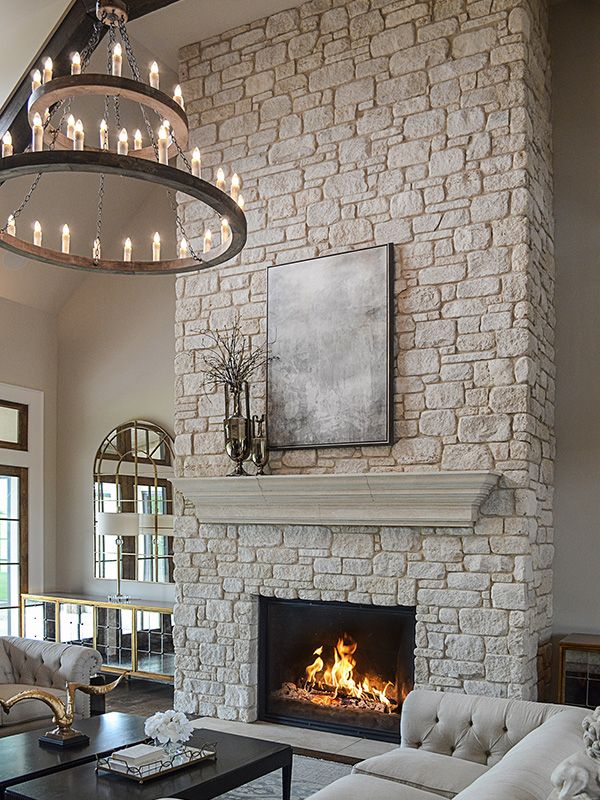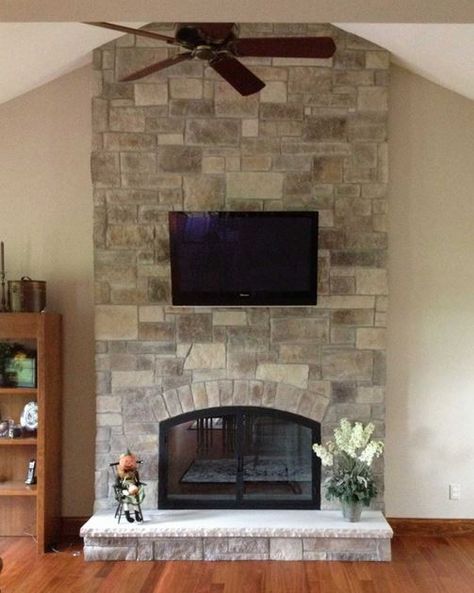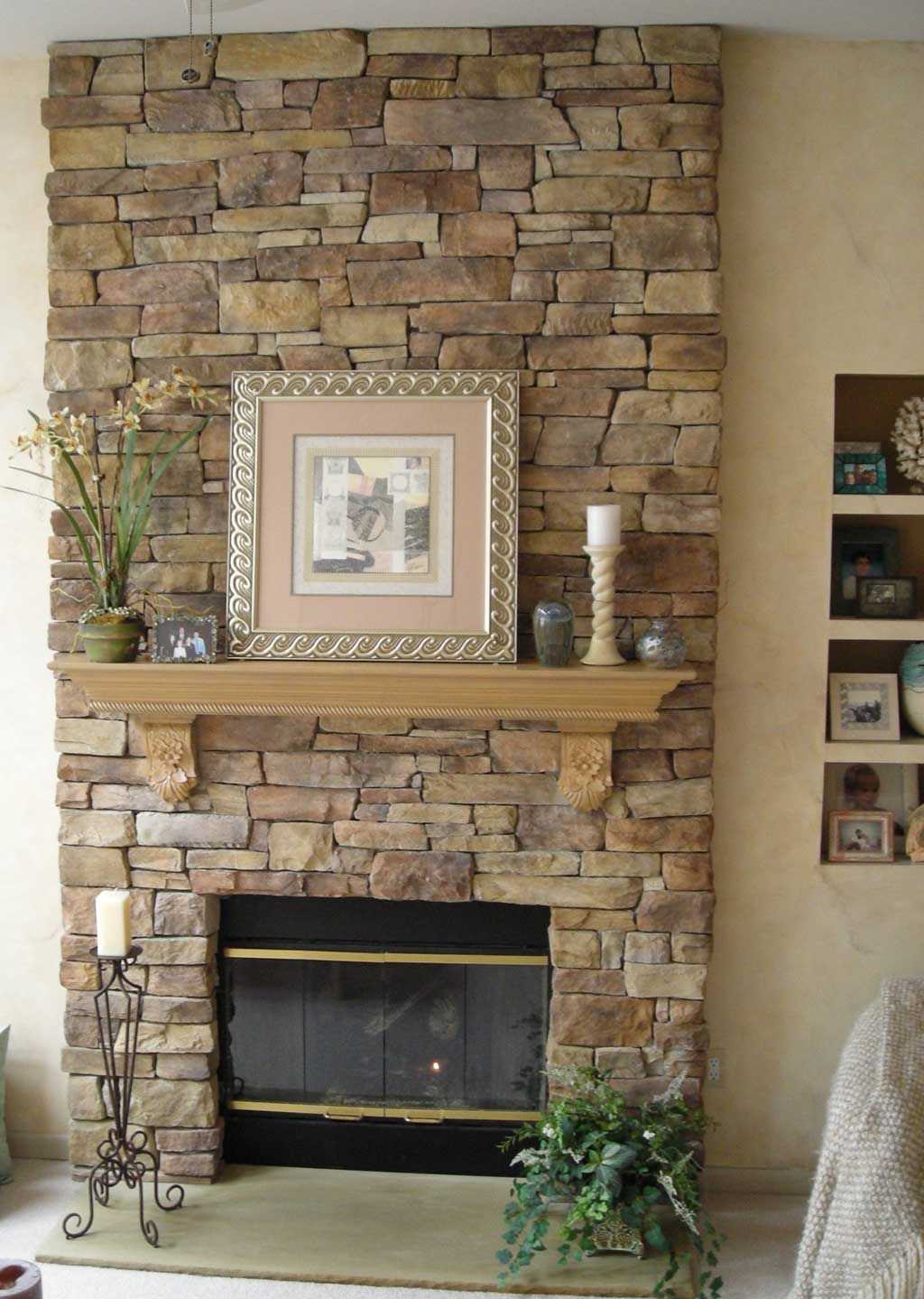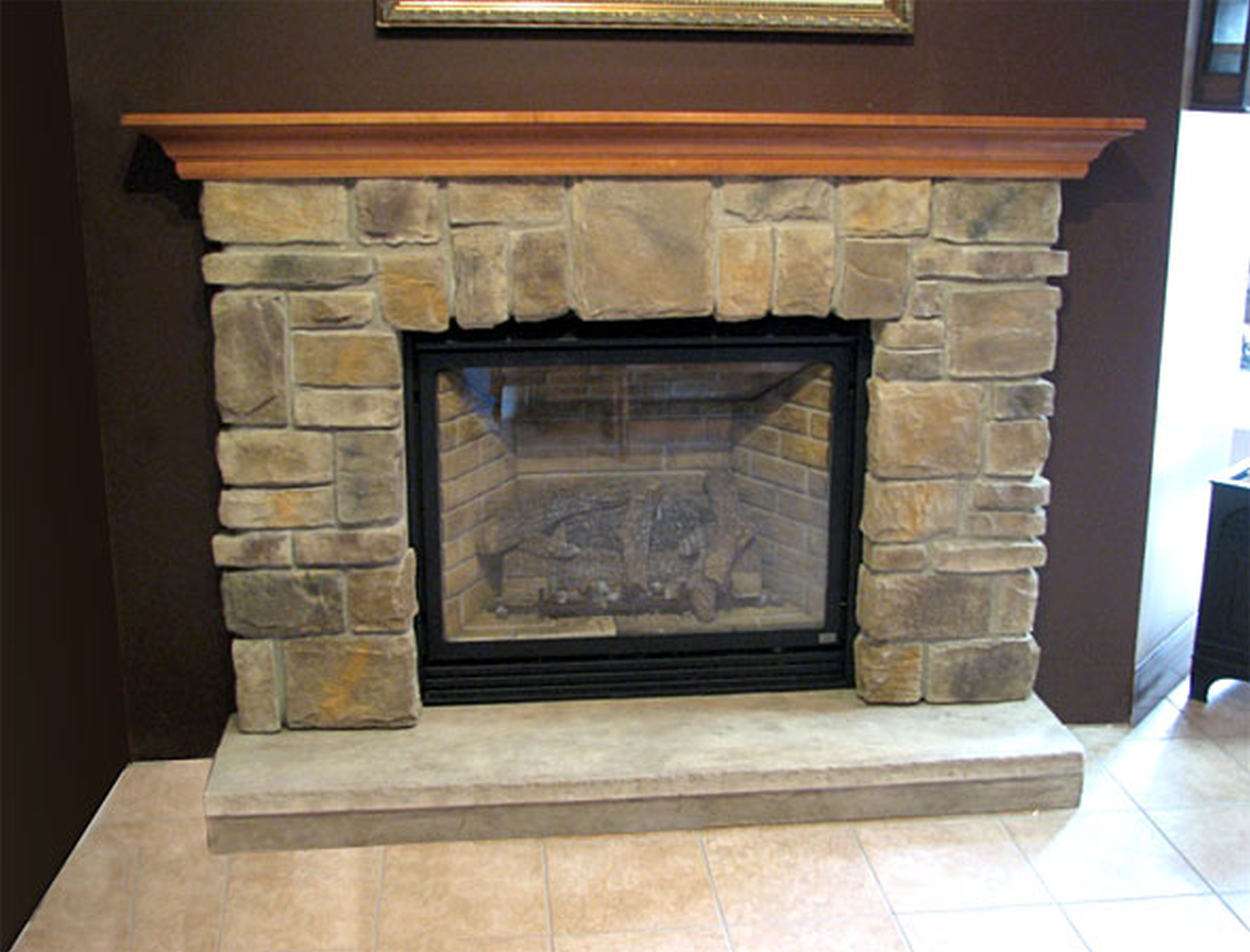A fireplace often serves as the heart of a home, providing warmth and a focal point for gatherings. Over time, however, its appearance can become dated or worn. Stone fireplace refacing offers an excellent solution to revitalize your fireplace and transform the ambiance of your living space. Let’s explore all aspects of stone fireplace refacing, from planning and materials to the installation process and maintenance. Additionally, we’ll cover common mistakes to avoid and answer frequently asked questions to help you achieve a stunning fireplace makeover.

Understanding Stone Fireplace Refacing
What is Fireplace Refacing?
Fireplace refacing involves updating the exterior surface of your existing fireplace without altering its internal structure. This process allows you to change the look of your fireplace, enhancing its aesthetic appeal and integrating it with your home’s decor. Stone refacing specifically uses natural or manufactured stone to create a beautiful, durable finish.
Benefits of Stone Refacing
Stone refacing offers numerous benefits:
- Aesthetic Appeal: Stone adds a timeless, elegant look that can transform your fireplace into a stunning focal point.
- Durability: Natural and manufactured stones are highly durable materials that can withstand heat and wear.
- Versatility: Stone is available in a variety of colors, textures, and styles, making it easy to find an option that matches your decor.
- Increased Home Value: A well-executed fireplace refacing can enhance the value of your home by improving its aesthetic and functional appeal.

Types of Stone for Refacing
There are several types of stone you can use for fireplace refacing:
- Natural Stone: Includes materials like granite, marble, slate, and limestone. Each type of natural stone offers unique colors and patterns, adding a one-of-a-kind look to your fireplace.
- Manufactured Stone Veneer: Engineered to look like natural stone, manufactured stone veneer is lighter and easier to install. It comes in a wide range of styles and colors, providing a cost-effective alternative to natural stone.
- Thin-Cut Stone: This is natural stone cut into thin slices, offering the durability and appearance of natural stone with easier installation.
Considerations Before Refacing
Before embarking on a stone fireplace refacing project, consider the following:
- Structural Integrity: Ensure that your existing fireplace structure is sound and capable of supporting the additional weight of the stone.
- Budget: Establish a budget that includes materials, labor, and any additional features or accessories.
- Design and Style: Choose a stone type and design that complements your home’s decor and personal style.
- DIY vs. Professional Installation: Decide whether you have the skills and time to complete the project yourself or if you should hire a professional.

Planning Your Stone Fireplace Refacing Project
Assessing the Existing Fireplace
Before you begin refacing, thoroughly assess the current condition of your fireplace:
- Check for Damage: Inspect the fireplace for any cracks, loose bricks, or other structural issues that need to be addressed before refacing.
- Measure the Surface Area: Measure the dimensions of the fireplace to calculate the amount of stone and other materials you’ll need.
- Identify Obstacles: Note any obstacles, such as mantels, hearths, or built-in features, that may affect the refacing process.
Selecting Materials
Choosing the right materials is crucial for a successful refacing project:
- Stone Type: Select between natural stone, manufactured stone veneer, or thin-cut stone based on your preferences, budget, and installation requirements.
- Mortar and Grout: Choose high-quality mortar and grout that can withstand high temperatures and provide a strong bond.
- Additional Elements: Consider additional elements like a new mantel, hearth extension, or decorative trim to enhance the overall look.

Design and Style Considerations
Your design choices will significantly impact the final appearance of your refaced fireplace:
- Color Scheme: Choose stone colors that complement your existing decor and create the desired ambiance.
- Pattern and Texture: Decide on the pattern and texture of the stone. Options include stacked, random, or uniform patterns, as well as smooth or rough textures.
- Accents and Details: Incorporate accents such as contrasting stones, decorative inlays, or a new mantel to add visual interest.
Budgeting for Your Project
Creating a detailed budget helps ensure your project stays on track financially:
- Material Costs: Include the cost of stone, mortar, grout, and any additional materials or tools.
- Labor Costs: If hiring a professional, obtain quotes from multiple contractors and factor in labor costs.
- Contingency Fund: Set aside a contingency fund for unexpected expenses, such as structural repairs or additional materials.

You May Want to Check These Articles:
- Trim Around Stone Fireplace
- Outdoor Stone Fireplace Plans
- Outdoor Stone Fireplaces Designs
- Stone Fireplace Pictures Ideas
- Stone Fireplace With Bookshelves

Installation Process
Preparing the Fireplace
Proper preparation is key to a successful installation:
- Clean the Surface: Thoroughly clean the existing fireplace surface to remove dust, dirt, and any loose materials.
- Repair Damage: Fix any cracks, loose bricks, or other structural issues to ensure a stable base for the stone.
- Apply a Bonding Agent: Apply a bonding agent or metal lath to the surface to improve adhesion for the stone.
Cutting and Fitting the Stone
Careful cutting and fitting are essential for a professional finish:
- Measure and Mark: Measure and mark the stone pieces to fit the dimensions and design of your fireplace.
- Cut the Stone: Use a wet saw or angle grinder with a diamond blade to cut the stone to the desired sizes and shapes.
- Dry Fit: Arrange the stone pieces on the fireplace surface without mortar to ensure a proper fit and achieve the desired pattern.

Applying Mortar and Setting the Stone
Setting the stone involves precision and attention to detail:
- Mix the Mortar: Mix the mortar according to the manufacturer’s instructions, ensuring the correct consistency.
- Apply Mortar: Spread a layer of mortar on the back of each stone piece and press it firmly onto the fireplace surface.
- Check Alignment: Use a level and spacers to ensure the stones are properly aligned and spaced.
Grouting and Finishing
Grouting and finishing touches complete the refacing process:
- Apply Grout: Once the mortar has set, apply grout between the stone joints using a grout bag or trowel.
- Smooth and Clean: Smooth the grout lines with a pointing tool and clean any excess grout from the stone surfaces.
- Seal the Stone: Apply a stone sealer to protect the surface and enhance its appearance.

Maintaining Your Stone Fireplace
Routine Cleaning
Regular cleaning helps maintain the beauty and longevity of your stone fireplace:
- Dust and Debris: Remove dust and debris from the stone surface with a soft brush or vacuum.
- Mild Cleaning Solution: Clean the stone periodically with a mild soap and water solution, avoiding harsh chemicals that can damage the stone.
- Avoid Scratching: Use non-abrasive cleaning tools to prevent scratching the stone surface.
Seasonal Maintenance
Perform seasonal maintenance to address any issues and keep your fireplace in top condition:
- Inspect for Damage: Check the stone and grout for any signs of cracking or damage and repair as needed.
- Seal the Stone: Reapply a stone sealer annually to protect the surface from moisture, stains, and heat damage.
- Chimney Maintenance: Ensure the chimney is clean and free of obstructions to maintain proper airflow and prevent creosote buildup.

Addressing Common Issues
Addressing common issues promptly can prevent further damage:
- Loose Stones: Reattach any loose stones with fresh mortar and grout.
- Stains: Remove stains with appropriate stone cleaners or poultices designed for your specific stone type.
- Efflorescence: Treat efflorescence (white mineral deposits) with a diluted vinegar solution or specialized stone cleaner.
Professional Inspections
Regular professional inspections can help identify and address potential problems:
- Chimney Inspection: Have your chimney inspected annually by a professional to ensure it is safe and functioning properly.
- Stone Inspection: Hire a professional to inspect the stone surface and grout for any signs of wear or damage that may require repair.

Enhancing Your Refaced Fireplace
Adding a New Mantel
A new mantel can enhance the overall look of your refaced fireplace:
- Material Options: Choose from a variety of materials, such as wood, stone, or metal, to complement your stone refacing.
- Style and Design: Select a mantel style that matches your decor, whether it’s rustic, modern, or traditional.
- Installation: Install the mantel securely, ensuring it can support any decorative items you plan to display.
Incorporating Hearth Extensions
A hearth extension can add functionality and visual appeal:
- Material Choices: Match the hearth extension material to your stone refacing for a cohesive look.
- Size and Shape: Determine the appropriate size and shape of the hearth extension to fit your space and design preferences.
- Installation: Install the hearth extension securely, ensuring it is level and stable.
Lighting and Accessories
Enhance the ambiance of your refaced fireplace with lighting and accessories:
- Lighting: Install accent lighting, such as wall sconces or recessed lights, to highlight the stone surface and create a warm glow.
- Decorative Accessories: Add decorative accessories, such as firewood holders, fireplace screens, and andirons, to enhance the overall look.
- Seasonal Decor: Change out seasonal decor, such as garlands, candles, and ornaments, to keep your fireplace looking fresh and inviting.
Integrating Technology
Modern technology can add convenience and functionality to your fireplace:
- Smart Controls: Install smart controls for your gas fireplace, allowing you to adjust settings from your smartphone or remote.
- TV Integration: Consider integrating a TV above the fireplace, ensuring proper heat protection and viewing angles.
- Sound Systems: Add a sound system or speakers to enhance the entertainment experience in your living space.

Common Mistakes to Avoid
Skipping Surface Preparation
Failing to properly prepare the fireplace surface can lead to poor adhesion and an uneven finish. Always clean, repair, and apply a bonding agent before refacing.
Using Incorrect Materials
Choosing the wrong type of stone, mortar, or grout can result in a subpar finish and durability issues. Select materials specifically designed for fireplace use.
Ignoring Weight Considerations
Overloading the existing structure with heavy stone can cause structural damage. Ensure your fireplace can support the additional weight or make necessary reinforcements.
Rushing the Installation
Rushing through the installation process can lead to mistakes and a less-than-professional finish. Take your time to measure, cut, and set each stone carefully.
Neglecting Safety Precautions
Failing to follow safety precautions, such as using proper ventilation and protective gear, can result in accidents and injuries. Always prioritize safety during the refacing process.

How much does stone fireplace refacing cost?
The cost of stone fireplace refacing varies depending on the type of stone, the size of the fireplace, and labor costs. On average, homeowners can expect to spend between $1,500 and $5,000 for a professional refacing job. DIY projects may cost less but require significant time and effort.
Can I reface my fireplace with stone myself?
Yes, you can reface your fireplace with stone as a DIY project if you have the necessary skills and tools. However, it requires careful planning, precise measurements, and attention to detail. If you’re unsure about your abilities, hiring a professional may be the best option.
How long does the refacing process take?
The refacing process typically takes 2-4 days, depending on the size of the fireplace and the complexity of the design. This timeframe includes surface preparation, stone installation, grouting, and finishing touches. Larger or more intricate projects may take longer.
Can I use any type of stone for refacing?
Not all stones are suitable for fireplace refacing. It’s important to choose materials that can withstand high temperatures and are specifically designed for fireplace use. Natural stones like granite, marble, and slate, as well as manufactured stone veneer, are popular choices.
How do I maintain my refaced stone fireplace?
Maintaining a refaced stone fireplace involves regular cleaning with a mild soap and water solution, annual sealing to protect the stone surface, and periodic inspections for any signs of damage or wear. Avoid using harsh chemicals or abrasive tools that can damage the stone.

The heart of your home, that once-grand stone fireplace, now whispers of neglect. Cracked mortar, faded grout, and chipped stone paint a picture of time’s passage. But despair not! A stone fireplace refacing is more than just a cosmetic upgrade; it’s a chance to breathe new life into your hearth, transforming it from a relic of the past into a stunning focal point that reflects your unique style and breathes warmth into your living space.
Related Posts:
- Stone Fireplace Before And After
- Stone Fireplace Decorating Ideas Photos
- Stone Fireplace Fronts
- Stone Fireplace Lintels
- How To Build An Outdoor Stone Fireplace And Chimney
- Stone Fireplace With White Mantle
- Stone Fireplace With Bookshelves
- Quartz Stone Fireplace
- Outdoor Stone Fireplaces Designs
- Stone Fireplace Kits Indoor